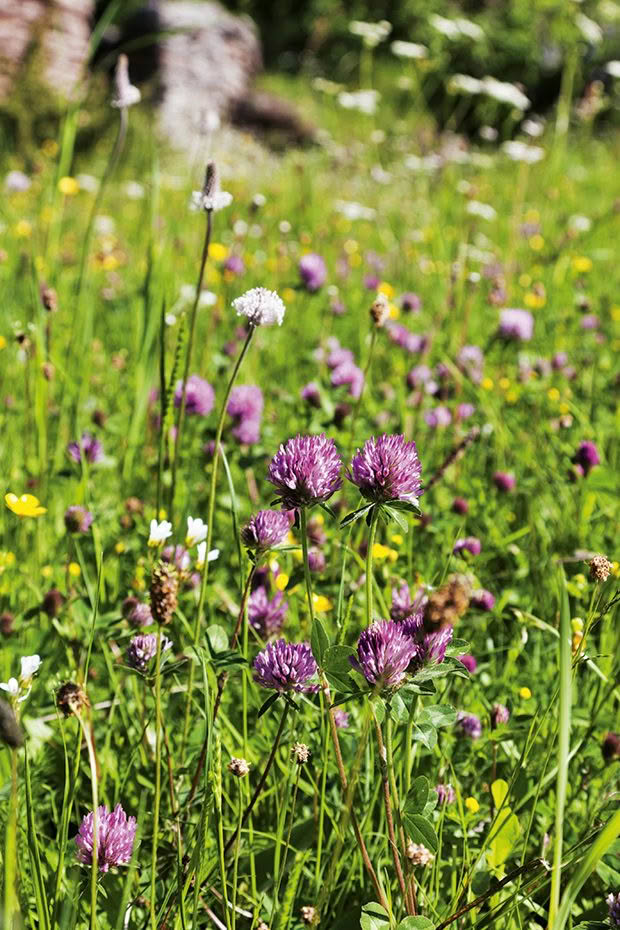Four tips for a bee-friendly lawn

The best ways to attract valuable pollinators to your lifestyle block.
Words: Michael Andrew
This month, spring will be luring many of us out of our warm houses and into the garden for longer spells. But it’s also the time when bees, butterflies and other insects, cold and hungry from a long winter, will be looking for food in the form of early-flowering plants. To encourage these pollinators, which the US Department of Agriculture estimates are responsible for one in every three bites of food we eat, it’s useful to assess how we treat our lawns. As the largest bodies of vegetation on many lifestyle blocks, lawns have the potential to be teeming with life and biodiversity depending on how we maintain them.
The relationship between lawn care and biodiversity has seen a boom in interest around the world. Since 2019 in the northern hemisphere, a growing number of people are embracing No Mow May – a movement that encourages property owners to take a break from mowing for the entire month of May in order to allow lawn plants and weeds to bloom, providing food for pollinators. It was started by British botanical charity Plantlife, which argues that excessive mowing damages the root structure of grasses and removes bee-attracting flowers. Based on survey results, Plantlife reported that limited mowing resulted in an increase in the pollen count of certain plants like germander, speedwell and white clover, which were valuable sources of food for bees and other insects.

However, letting a lawn grow for a full month might not be everyone’s cup of tea, and some argue that it could be doing more harm than good, especially if the grass is cut too short at the end of the month. That’s because the general rule of thumb suggests you should never remove more than one third of leaf tissue at one time to reduce stress on your grass and prevent your lawn from thinning out.
So rather than operating at the extreme ends – blitzing your lawn every few days or neglecting it for a whole month – it may be better to try other methods to attract pollinators while keeping your grass in good condition.
FIND THE RIGHT HEIGHT

It’s only natural to see a wild winter-rich lawn and have an urge to slash it back down to a more respectable, orderly height. But shorter is not better when it comes to healthier grass. Taking too much off at once will weaken the blades and roots and hamper its ability to create nutrients.
It’s best, therefore, to cut grass at a height of three inches, or around 7.6cm or higher. This will help develop a dense, healthier root system and make your grass more resistant to erosion and water shortages.
FIND THE RIGHT FREQUENCY
While a month might be a long time for someone to go without mowing, it’s possible to give yourself an extra week between cuts in order to let flowers emerge and draw in bees and other pollinating insects to your property. Around the world, there has been increasing enthusiasm for “lazy lawns” – lawns that are mown less frequently than the traditional one-week trim common in western countries. One 2018 study found that lawns mowed once every two or three weeks supported higher numbers of both lawn flowers and honey bees.
CREATE MINI MEADOWS

Leaving patches of long grass is a great way to strike a balance between orderliness and biodiversity. By creating mini meadows – designated sections of your lawn where the grass is allowed to grow long and flower – you can bring in pollinators with a regular food source. At the same time, you can keep the rest of your lawn in more tidy condition.
CONSIDER PLANTING A BEE LAWN
It’s possible to sow a lawn that provides excellent food for bees while being far easier to maintain than other grass. Known as a “bee lawn”, it’s comprised of low-growing plants that produce flowers with very high nectar content. One increasingly popular lawn alternative is clover, which not only attracts pollinators with high-nectar flowers, but is also drought resistant, doesn’t require any herbicide or pesticide and requires far less mowing. Both white clover (Trifolium repens) and red clover (Trifolium pratense) are nutritious pasture crops that fix nitrogen into the soil and make it available to other plants.

Other high-nectar plants for lawns or mini meadows include:
• Selfheal (Prunella vulgaris)
• Dandelion (Taraxacum spp.)
• Common daisy (Bellis perennis)
• Oxeye daisy (Leucanthemum vulgare)
• Cat’s-ear (Hypochaeris radicata)
To create a flowering lawn, seed in early spring. Mow the lawn as low as possible and rake the clippings to expose as much soil as you can. Sow the seeds with some compost to help the seeds germinate. Gently rake the area immediately after seeding to prevent soil compaction and help the seeds settle. After seeding, the area should be watered gently for the first two to three weeks until the plants begin sprouting. (Source: Michigan State University)
Love this story? Subscribe now!
 This article first appeared in NZ Lifestyle Block Magazine.
This article first appeared in NZ Lifestyle Block Magazine.
